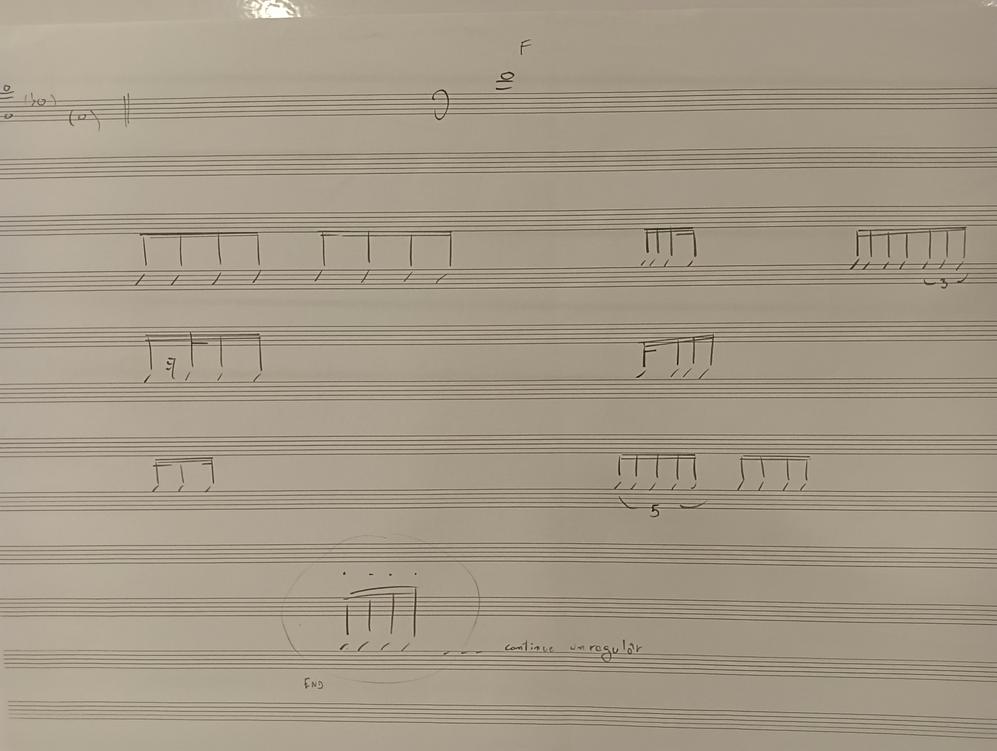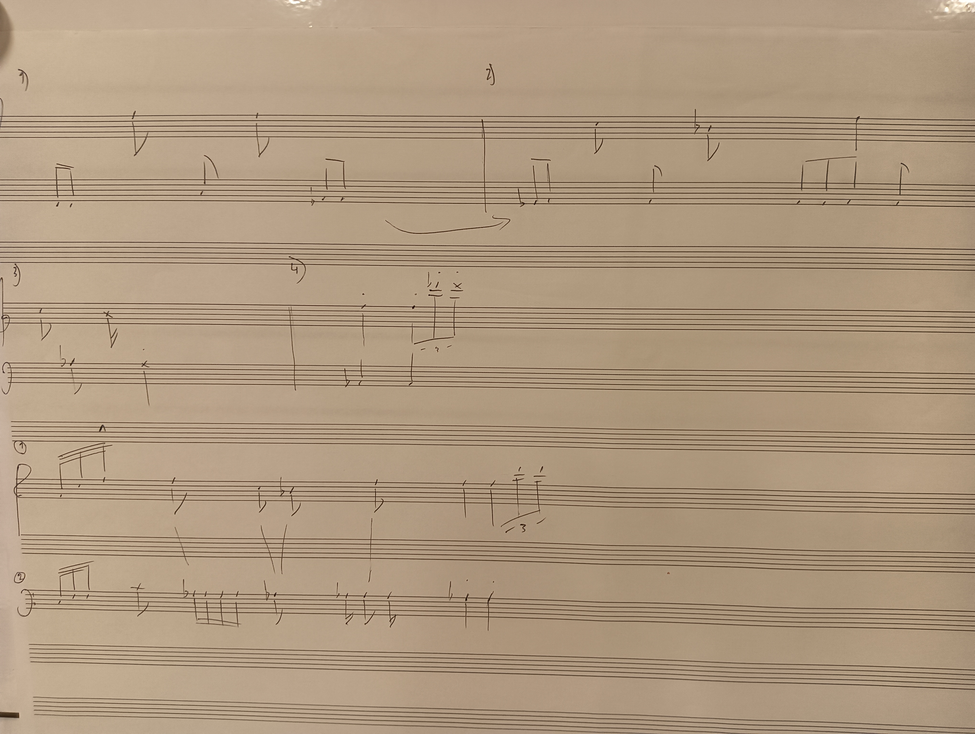The musicians who contributed to the project include:
Alex Ventling, Michaela Turcerova, Asger Thomsen, Irene Bianco, Sarah Buchner, Jan Kadereit, Judith Parts, Aurelijus Užameckis
I will endeavor to translate the electronically processed material back into the realm of acoustic sound. This process will entail close collaboration with instrumentalists and necessitate a deep understanding of how to achieve or suggest "impossible" sonic outcomes through the use of extended techniques. It will also involve discussions on effectively translating musical ideas in a creative manner.
I have spent many years working with acoustic ensembles and improvisational concepts, consistently incorporating digital sound into my work. Now, I aim to refine my technical production-based skills, including recording, mixing, and mastering. I am seeking suggestions and constructive feedback on writing scores, with a focus on their functional efficiency rather than their visual aesthetics. Furthermore, I aim to approach acoustic music in a different way, drawing inspiration from some remarkable contemporary composers who exhibit exceptional control, experience, and elegance in their arrangements and timbral choices, rooted in profound knowledge (Anders Lauge Meldgaard, Simon Steen-Andersen, Peter Thoegersen).
The original material comprises sound recordings made over the past year, including flute, my self-constructed prototypes of the "flaubosax," drums, electric bass, upright bass, cello, viola, violin, vibraphone, piano, guitar, vocals, and various kinds of feedback.
- ANALYSIS, SELECTION, REFLECTION ON POSSIBLE WAYS OF TRANSLATION, NOTATION OF TRANSCRIPTION
Now that the first phase was completed, I had some defined material I could start analyze, dismember and dissect, trying to point out the elements I believe characterize the music: in doing so, I related again on my listening and impressions I assimilated through a continuous connection with the material. Following, I have listed the qualities, with a note/ first reflections on “what” they would require concretely to be translated into the acoustic domain/related reflections
- CLARITY / DEFINITION OF SOUND
the attack and decay of each sound element is exact and sharp, its bi-dimensional quality, together with the neutrality of the timber, make it sound artificial and perfectly controlled. This quality is related to the physical features of the instrument and the instrumental skills of the musicians: some instruments in fact, may easily reach such a definition, while others are known for their more expressive/human qualities. The playing style is also very important: during our instrumental education, we usually aim for a personal, unique expressive sound, instead, in this case, it is necessary to be able to play in a linear, uniform, and neutral style, with great control of the dynamic possibilities. I believe this is generally quality researched for orchestral musicians. This information would give me a direction in the future choice of the musicians/instruments
- SEPARATION (SPATIALITY) / UNITY
all the elements are very clearly defined and separated from each other, as a result of the definition of sound, reinforced by the extreme panning of complementary events; I think it generates a dichotomy, between Unity / Separation: we hear a dense textural mass, like a magmatic wall of sound, and at the same time, we can hear the single grain in its integrity, as it can be perceived into different layers. I would visually describe it as when observing the sea, we see the immense water unity in its totality but still can recognize each electric sparkling drop composing it.
We can recreate this effect simply with the placement of the musicians in the space, or by applying microphones really near the instruments to reinforce the effect with the use of the PA system (from two to eight speakers? ); we could also heavily intervene on the voices, interconnection them through side-chain compressor/gate.
- MULTI TEMPO
When I listen to the material I clearly perceive the feeling of multi-tempo in how the voices interact with each other. This aspect in part reflects the previous point (separation/unity), but under a rhythmic perspective; it is as if every voice has its own flow, its own micro-system, which on a larger scale interacts with the others in a bigger orbit system we can “feel” but not completely understand. With an acoustic ensemble, we can attempt to reach this quality in different ways:
- playing different unusual metric subdivisions simultaneously
-
- have the musicians playing on different metronome pulses (on headphones): in this way, the musicians would be inevitably more isolated, not listening to the sound around them but instead concentrating on their single part; this would be worth experimenting, and I always had a fascinated with the idea musicians used as pieces of a bigger puzzle they do not have to understand in its totality.
-
- think about the inter-correlation of the voices: there is not a pulse to relate to, but each note/hit is simply related to the previous one and to the one following: in this way, the musician has a margin of decision, that consists of deciding when playing after he/she hears the previous event, generating a “concatenative” rhythm with the full ensemble: this practice would require a considerable amount of rehearsal where the musicians would get familiar with the technique, assimilate a feeling of complementarity with the full ensemble before becoming effective.
Reflecting on the music on a deeper level, I started recognizing a certain “motion”, patterns that relate to sounds produced by mechanical, physical action, “natural” sounds dictated by gesture and gravity, that do not respond to human pre-established musical parameters. It is curious how in the first semester, through the process of decomposition, processing the sounds in a violent, destructive manner, I thought I was pushing the sound to a brutal dehumanization and discomfort, while I was probably unconsciously trying to reach structures that would relate to the universal laws of nature.
GOING INTO TRANSLATION
Language is music with a new semantic layer. So we can easily apply translation theory to music, particularly if we use a multi-level approach, by merely ignoring the missing semantic layer. This concept leads us to the idea that translation can operate on different levels; Translation always constitutes a transformation and its primary purpose is to conserve or preserve the original text. My primary intention in translating music is to preserve the beauty and ideas it contains, being able to extrapolate its founding concepts and make them available for the most despaired musical domains.
When going into translation, it is good to underline two different approaches we can use in order to reach our goals: a mimetic approach can produce results that sound similar to the target, but are probably less interesting for composers, as we are looking at the discrepancies and differences from the original as a source of artistic creation; the kathartic approach, instead, is meant to generate translations that are not always close to the target but are considered musically interesting, and eventually can bring us to dare into exploring new territories.
METHODS:
1- Listen and repeat / listen repeatedly, sing, assimilate, and notate; I classified the material into different layers (rhythmic, harmonic, melodic) and tried to discern different voices and rhythms; I would alternate the priority from rhythm and how the multi tempo interlock with each other (when this happen), and melodic/harmonic movements, when these are more enhanced. I would isolate micro-phrases, and focus on single fragments, transcribe them; and harmonic/ melodic approximative notation of sections.
2- Stretching / pitch shifting with the support of the software (Ableton / Audacity) I can pitch the recording down maintaining the rhythmic relationship between the elements: this allows me to hear the track slower and clearer, but also considerably compromises the “perspective” of how we listen to the audio.
3- Isolate the different voices through the use of equalizers and filters in Ableton Live
4- Visually Look at the track trying to identify different pulses/motivic figures; manually RE- Construct these hits via MIDI in a new MIDI track.
5- Isolate each tempo - transcribe different phrases with different pulses - transcribe simple phrases meant to be played in different tempo - find the intercorrelation within the voices / extrapolate the intrinsic structure
6 - Ableton harmony/melody/rhythm to MIDI conversion tool this command identifies the pitches in a polyphonic/monophonic (harmony/melody) audio recording and places them into a clip on a new MIDI track. This command does not play the original sound, but instead extracts the notes and uses them to play an entirely different sound. the Drum to Midi conversion extracts the rhythms from un-pitched, percussive audio and places them into a clip on a new MIDI track, also attempts to identify kick, snare, and hi-hat sounds and places them into the new clip. These Ableton tools do not take the parameter of timbre under consideration at all; they are supposed to convert simple audio files into MIDI, so when a complex, un-regular audio source is converted, the result is over-simplified and very far from the original recording, although most percussive accents and some harmonic/melodic tones survive after the translation
7 - Orch-Idea Orchidea is a software developed by Carmnine-Emanuele Cella, Daniele Ghisi, and Alessandro Petrolati, in collaboration with Ircam, HEM Geneve, and UC Berkeley; it is a framework for static and dynamic computer-assisted orchestration. Assisted orchestration can be thought of as the process of searching for the best combinations of orchestral sounds to match a target sound under specified metrics and constraints.
8 - Creative collaboration with the instrumentalist At this phase, I would present one or more of the translations I produced (generally always trying not to write a “scary” score, simplified) to the musicians, talk about the elements and concepts I consider relevant; I would focus on fragments, as I believe these contain the essence of the music, and I would have the musician play it to get familiar with the notes and technique. later, I would have them listen to the music and play along; finally, in the last take, I would ask them to use all the information assimilated through reading and listening, and play again: in this way, I achieve
1) a recorded impression as a result of reading the notated material,
2) a more musical imitation-based approach, and
3) a creative abstraction dictated by the previous information mixed up with the personality/ of the musician. I wanted to build an active collaboration that would result in interesting for the musicians, and not necessarily have them playing exactly as in the recording, but transmit to them a general concept/idea, they could play with, starting a reciprocal constructive dialogue between composer and executor. In other cases, I would experiment and discuss with the musicians how to reach a specific sonic result through the use of extended techniques (a sound wall, a texture, or generally everything I would not find helpful to notate into rhythms and tones).


